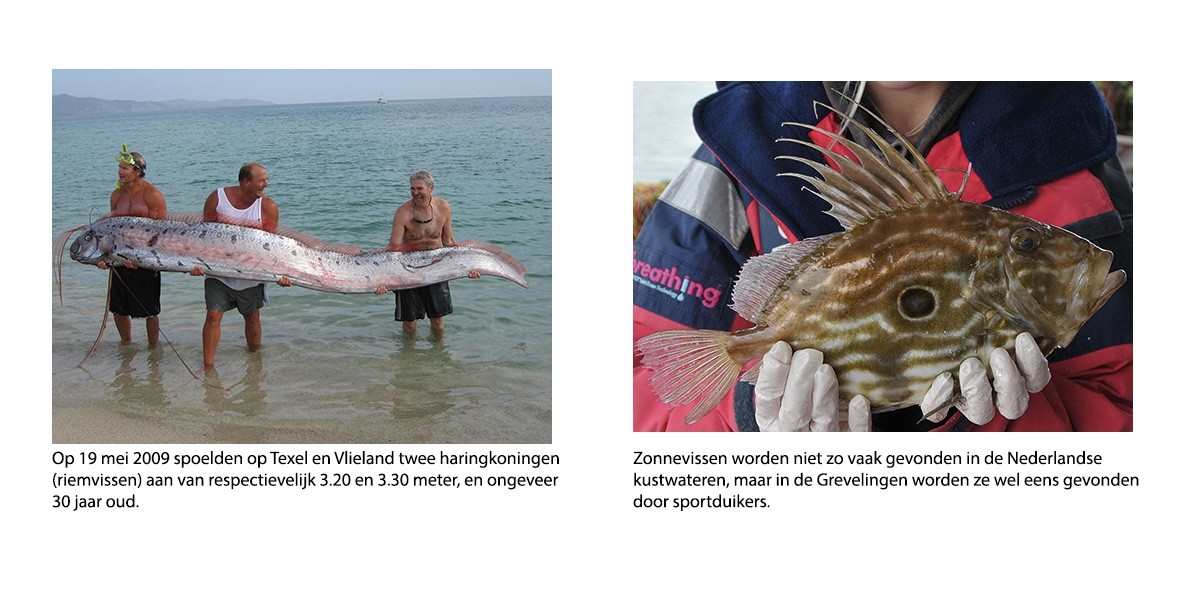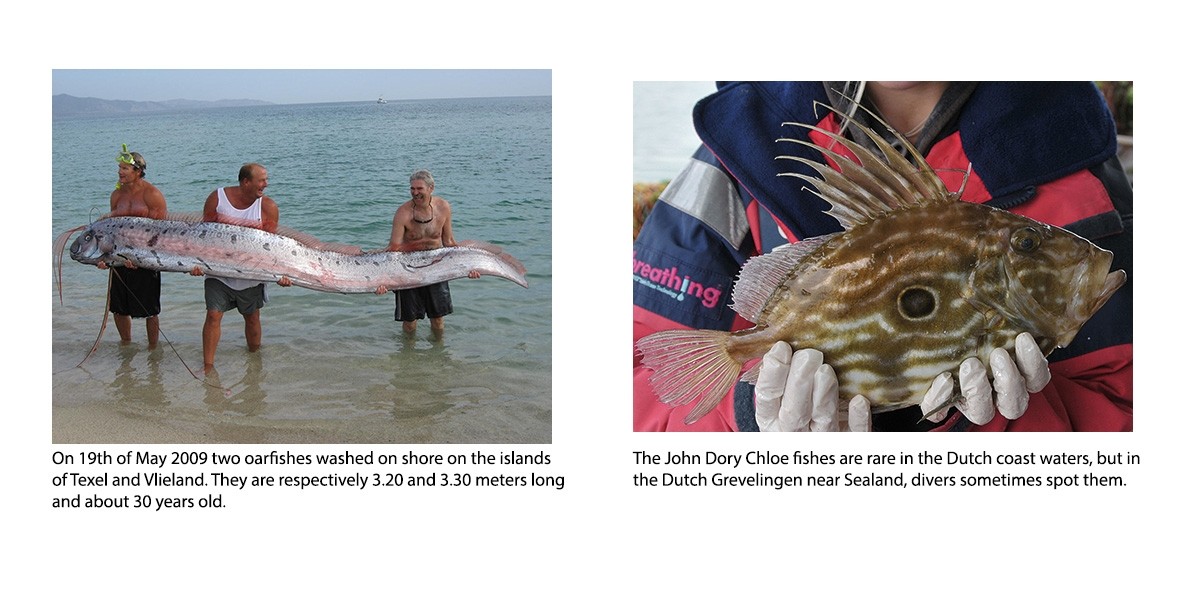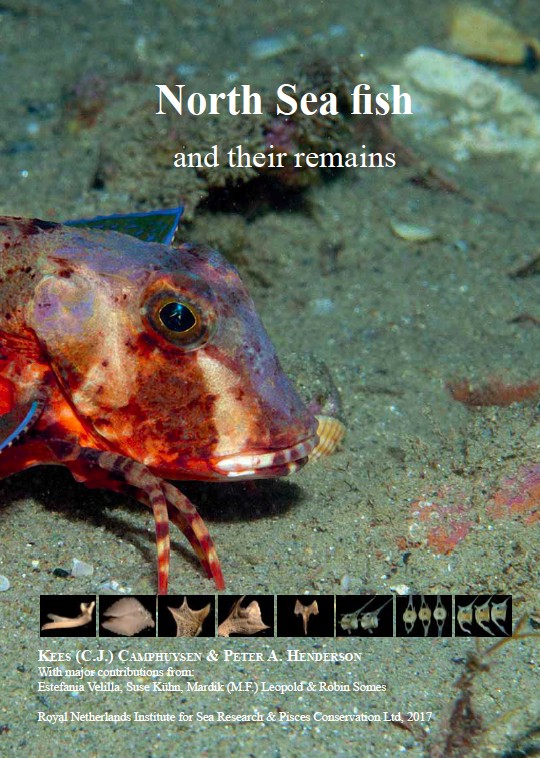Boekpresentatie: North Sea fish and their remains - Kees (C.J) Camphuysen & Peter A. Henderson
North Sea fish and their remains - Kees (C.J) Camphuysen & Peter A. Henderson
Een uniek naslagwerk over de vissen van de Noordzee en de Waddenzee
Wie denkt te weten welke vis te vinden is in de Noordzee, kan er flink naast zitten. De visatlas North Sea fish and their remains ontrafelt het mysterie van de vissen die zwemmen in de ondoorzichtige Noordzee. De diversiteit aan vis zal voor veel lezers een verrassing zijn want Noordzeevis ziet er niet bepaald hetzelfde uit als de vis in restaurants of supermarkt. Neem nou bijvoorbeeld de indrukwekkende Haringkoning en de Zonnevis. Deze gids, uitgegeven door Pisces Conservation Ltd (UK) en het NIOZ, Nederlands Instituut voor Onderzoek der Zee, voorziet wetenschappers, (amateur)vissers en beleidsmakers van nieuwe informatie over natuurlijke voedselbronnen in de Noordzee. Maar het boek is ook gebruiksvriendelijk voor consumenten die lokale vis willen kunnen herkennen, wat kan helpen om meer vraag naar duurzame vis te creëren. ~~~~ English translation below ~~~~

Visresten bieden ook archeologen en klimaatwetenschappers inzicht
De visatlas geeft wetenschappers houvast om vissoorten te herkennen en vast te stellen. Aan de hand van eenvoudige sleutels, heldere schetsen en duidelijke kleurenfoto’s kunnen zo’n 150 veelvoorkomende soorten vastgesteld worden zoals haaien, roggen, ponen en platvissen. Het meest bijzondere aan dit boek is dat mariene ecologen Kees Camphuysen (NIOZ, Texel) en Peter Henderson (Pisces) uitgebreide informatie hebben toegevoegd over de herkenning van vissoorten aan de hand van hun overblijfselen (‘visresten’, zoals gehoorsteentjes, wervels, kaken, schubben en stekels). Visresten worden gebruikt door biologen om het dieet van viseters te reconstrueren, door archeologen om de historische economische reconstructies te doen aan de hand van opgravingen en door geologen om afzettingen van visresten te gebruiken voor bijvoorbeeld klimaatreconstructies. Het is voor het eerst dat een zo uitgebreid en gedetailleerd overzicht van ‘visresten’, in kleur geïllustreerd, in boekvorm wordt uitgebracht.
Ruim 40 jaar visvangsten in beeld
Om de herkenning te vereenvoudigen zijn de vissen voor het merendeel buiten het water gefotografeerd, precies zoals ze door een visser gezien zouden worden. Daarnaast geeft de tekst uitleg over hoe soorten herkend en geïdentificeerd kunnen worden met daarnaast informatie over hun voorkomen, commerciële betekenis, levenswijze en ecologie.
Trends en seizoenspatronen Waddenzee
De informatie over de vissen zelf en over hun identificatie is hoofdzakelijk gebaseerd op de enorme ervaring die de afgelopen 40 jaren is opgedaan door het Britse Pisces team. Dit deel van het boek is gebaseerd op Peter Henderson’s eerdere boek, uitgegeven in 2015, Identification Guide to the Inshore Fish of the British Isles. Kees Camphuysen heeft de tekst herzien en gereorganiseerd, vissoorten geschrapt en toegevoegd, om het boek zo van toepassing te laten zijn op de Noordzee en de internationale Waddenzee. Bijzonder is ook de toevoeging van de trends en seizoenpatronen in visvangsten in een vaste fuikopstelling van het NIOZ in het Marsdiep (Texel), waarmee visstanden en soorten al sinds 1960 gevolgd wordt..
De auteurs hebben gekozen de algehele voedselketen van de Noordzee in kaart te brengen. Daarbij baseerden zij zich op het kortgeleden gepubliceerde standaardwerk Fish atlas of the Celtic Sea, North Sea, and Baltic Sea” (Heessen et al. 2015). De beschrijvingen zijn grotendeels op deze atlas geënt, aangevuld met andere bronnen waar het om meer pelagische soorten ging. Het resultaat geeft een uniek overzicht van de mogelijkheden tot visidentificatie op basis van hun overblijfselen. Dit deel van het boek is gebaseerd op tientallen jaren onderzoek aan het voedsel van visetende zeevogels en zeezoogdieren op het Koninklijk Nederlands Instituut voor Onderzoek der Zee (NIOZ) en bij Wageningen Marine Research (WMR). Het boek mag worden gezien als een uitgebreide introductie voor biologen, geologen en archeologen, of het nu amateurs zijn of professionals en het sluit aan op een collectie online factsheets.
~~~~ English translation ~~~~
North Sea fish and their remains - Kees (C.J) Camphuysen & Peter A. Henderson
A book to aid the identification of marine and estuarine fish in the North Sea
Get to know your local fish! North Sea fish and their remains unravels the secrets of what swims in our dark green or somewhat brown sea. Some readers will be surprised to discover that North Sea Fish does not necessarily look like what you find on your plate or in the nearest supermarket. This guide published by Pisces Conservation Ltd (UK) and NIOZ Royal Netherlands Institute for Sea Research, helps consumers to make a more educated choice and provides scientists with knowledge of the natural resources within the North Sea, creating an awareness that is essential steps for sustainable fisheries and fish consumption in the future.

This book provides the authoritative fish identification source for almost 150 species, with colour images and B/W illustrations of each species, and detailed information on identity, distribution, food, life history and ecology. The most unique characteristic of this book is that marine ecologists Kees Camphuysen and Peter Henderson have added detailed information on the identification of fish remains such as fish bones, otoliths and scales.
Fish remains may be encountered when the diets of marine predators like whales, dolphins, seals, seabirds and predatory fish are studied during archaeological excavations or geological reconstructions. It is the first time that such a comprehensive overview of the smallest fish bones of North Sea fish species has been put in to print. In this book most specimens are photographed out of water and supported with line drawings showing the layout of the fins and body shape.
The information on fish identification and life-histories in this book is based largely on experience gained by the UK Pisces team over nearly 40 years and follows Henderson’s 2015 work, Identification Guide to the Inshore Fish of the British Isles. Camphuysen reorganized the text and changed the focus to the North Sea and the international Wadden Sea. The latter included information on seasonalities and trends in catch rates of fish entering the western Dutch Wadden Sea based on the constant effort site ‘fish fyke’ of NIOZ Texel that is in operation since the 1960s.
The authors briefly describe the overall distribution, largely with reference to the recently-published and highly comprehensive “Fish atlas of the Celtic Sea, North Sea, and Baltic Sea” (Heessen et al. 2015). A comprehensive description and beautiful illustrations of ‘remains’ of fish were included, making this book truly unique. The information about the identification of fish remains is largely based on experience of the NIOZ Royal Netherlands Institute for Sea Research and WMR Wageningen Marine Research, institutes that have studied the North Sea diets of seabirds and marine mammals for over 30 years. This part of the book must be seen as an introduction for professional and amateur biologists, geologists and archaeologists alike, interested in the reconstruction of the use (as prey, or as food) or abundance (as geological deposits) of fish in historical times, or by certain piscivorous predators.

‘North Sea Fish and Their Remains’, ISBN 978-1-904690-65-8
Lees hier een preview van de visatlas
Uitgave: Harde kaft
Taal: Engels (onder toevoeging van Nederlandse, Duitse, Deense en Noorse namen)
Pagina's: 326
Prijs: 50 euro’s
Portokosten (Nederland): 6,95 euro
Online bestellen
Als je in Nederland woont, kun je het boek hier bestellen.
Direct bestellen bij het NIOZ?
Stuur een email met je naam & adres naar: finance@nioz.nl. Wij sturen het boek op zodra de betaling van 56 euro (incl bezorgkosten) in orde is.

Website
Omdat het boek geen compleet naslagwerk betreft, hebben de onderzoekers een website van de visatlas in het leven geroepen. Op www.northsea-fish.com zullen updates te vinden zijn wanneer nieuwe informatie over visrestanten, soortverdeling en taxonomie beschikbaar komt.
Doelgroep
Deze visatlas is geschikt voor iedereen die geïnteresseerd is in Noordzeevis en in de herkenning van verschillende vissoorten aan de hand van simpele kenmerken, zoals hengelaars, beroepsvissers, vishandelaren, biologen, natuurvrienden, studenten en professionele biologen, geologen en archaeologen.

‘North Sea Fish and Their Remains’, ISBN 978-1-904690-65-8
Reading preview available here.
Format: Hardcover
Language: English
Pages: 326
Price: 50 euro’s
Delivery costs (for The Netherlands only): 6,95 euro
Order online
You can be purchase online from Pisces Conservation Ltd.

Website
The book has a website to provide updates as more research on fish remains, species distribution or taxonomy becomes available, and to share far more detailed information on remains of key species than can be fitted into the book.
Readership
The book is intended for everyone with an interest in the identification of fish, including anglers, professional fishermen, fish merchants, naturalists, students, post-graduates and professional biologists, geologists and archaeologists.
